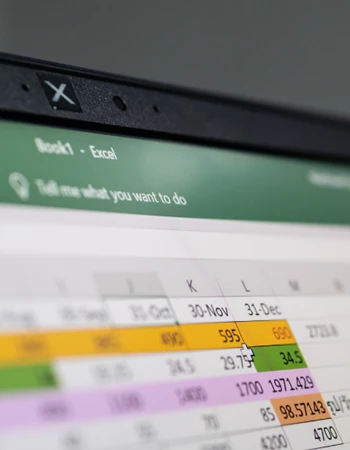
What is Production Planning?
This article dives into the benefits of production planning, the production planning process and what tools are available to support production planning.
 6 minutes
6 minutes
Written by Rod Schregardus, Production Planning/Scheduling solutions specialist
What is Production Planning?
Success in the world of manufacturing and industrial production hinges on delivering high quality products in an efficient and cost-effective manner; and that’s only possible for businesses with a clear production plan in place.
The production planning process involves forecasting demand and mapping out the resources, raw materials, labour and equipment needed to fulfil orders on time. The idea is to establish a reliable schedule that runs smoothly, covers all areas of operations and produces minimal waste. Contingency planning is also essential to pre-empt unexpected issues and delays, and avoid costly downtime as a result.
Effective planning takes time and investment, which is why many manufacturers are turning to digital tools and production planning software to support managers and staff. If you’re currently evaluating your own approach to production planning, this guide will walk you through everything you need to know.

10 benefits of Production Planning
- Increased capacity - Strategic scheduling and resource allocation is crucial for manufacturers looking to reach their maximum output potential. Increased capacity means that businesses can fulfil more orders and scale operations without overextending resources.
- Improved productivity - Manufacturers can achieve higher levels of operational efficiency by streamlining workflows and minimising bottlenecks. This leads to reduced lead times, faster time-to-market and quicker delivery throughout the production process.
- Cost reduction - Trimming costs wherever possible is a key aim for most businesses, particularly in supply chain industries that involve many moving parts. Through production planning, manufacturers can highlight inefficiencies at different stages and take steps to remove any expenditure considered unnecessary.
- Enhanced quality control - Providing real-time visibility into production processes helps managers to identify issues early on and ensure compliance with predefined quality standards. This preventative approach minimises the chance of defects reaching the final product line, reduces the need for rework and leads to a higher overall quality of product.
- Timely delivery - Production planning helps managers to optimise schedules and avoid any clashes in terms of resource or labour allocation. This is where effective demand forecasts pay dividends by giving manufacturers a clear view of what’s needed ahead of time.
- Efficient workflow - Automating repetitive manual processes is one of the main reasons why more and more manufacturers are investing in modern production planning software. Not only does this reduce the likelihood of human error and increase workflow efficiency, it also frees up teams to focus on more strategic, valued-added tasks.
- Effective demand fulfilment - Production planning is instrumental when it comes to aligning production capacities with market requirements. This proactive approach ensures that products are available when needed, preventing stockouts and minimising surplus inventory.
- Risk mitigation - By providing real-time visibility into the entire production process, managers are in a better position to spot supply chain disruptions, equipment failures or unforeseen changes in demand. They can then implement contingency plans and make informed decisions to mitigate the impact of risks on production schedules.
- Strategic decision-making - A good production planning software will offer automated reporting capabilities, making it easy for managers to turn raw data into actionable insights that can be shared with senior leaders and other key stakeholders within the business.
- Competitive advantage - The cumulative effect of these benefits has a huge impact on the performance of manufacturing businesses and the strength of their position in the market. By contrast, any manufacturing that fails to take a proactive approach to optimising production planning is likely already falling behind the competition.
What's the difference between Production Planning and Production Scheduling?
Production planning and production scheduling are complementary processes that can be used alongside one another to great effect. However, there are several key distinctions which manufacturers need to understand before investing in either process:
Production planning
- Scope – Production planning involves creating a comprehensive framework of systems and processes. It is crucial to define the scope of operations, main production goals and strategic direction the company is taking.
- Long-term perspective – Forecasting future demand and considering market trends over an extended timeframe are both crucial to navigate challenges and achieve sustainable growth over time.
- Capacity planning – Effective production planning ensures that manpower, machinery and raw materials are always synchronised, which prevents overloading or underutilised resources.
- Strategic approach – Top manufacturers take time to scrutinise past approaches, understand customer demands and map out obstacles to growth as part of the production planning process.
Production scheduling
- Focus – Unlike production planning, production scheduling focuses more on the day-to-day allocation of resources and immediate production demands.
- Short-term perspective – Rather than long-term plans for growth, scheduling is more concerned with short-term delivery and efficient allocation of resources on a micro level.
- Finite scheduling – Through finite scheduling methods, manufacturers can determine specific time slots, start dates and ETAs for every task or operation they undertake.
- Tactical implementation – Production scheduling deals more with the detailed coordination of activities within the broader framework set by production planning. It focuses on the nuts, bolts and immediate goals of the manufacturing process.
What is involved in the Production Planning process?
- Forecast demand. Production planning starts by digging into historical data, market trends and other relevant factors to get a clear idea of the quantity and quality of product needed to meet customer requirements. Accurate demand forecasting is crucial for avoiding overproduction or stockouts, ensuring optimal inventory levels and enhancing overall operational efficiency.
- Determine options for production. Once the demand is forecasted, organisations need to research the various production options available to them. Some manufacturing processes, technologies and supply chain strategies will be more feasible than others depending on the nature of the business. Cost implications, production speed, scalability and environmental impact are usually key factors to consider.
- Choose the option that uses resources most effectively. After exploring multiple options, businesses can then choose the production method that aligns with their goals and constraints. Efficient resource utilisation is paramount in production planning, so the end goal is to maximise productivity while minimising waste. The chosen approach should also balance cost-effectiveness with the ability to meet demand requirements.
- Self-assess your performance. Regularly assessing the production process is crucial for ongoing improvement and optimisation. This step involves setting KPIs and benchmarking progress over time. By conducting self-assessments, manufacturers can identify areas of improvement, address inefficiencies in production and reach higher levels of performance.
- Adjust. Flexibility is vital throughout the production planning process and businesses need to be agile enough to make necessary adjustments whenever there’s an issue or change in market conditions. That may include modifying production schedules or resource allocation to stay competitive and resilient whenever unexpected challenges arise.
5 different types of Production Planning
- Master Production Scheduling (MPS) - Master production scheduling involves the planning of quantity and timing of production for each end product, taking into account key factors such as customer demand, available inventory and production capacity to develop a comprehensive schedule.
- Material Requirement Planning (MRP) - MRP is a systematic approach to procuring and managing the materials needed for production. It allows manufacturers to analyse the demand for finished goods and determine the necessary raw materials and components they need to deliver.
- Capacity Requirement Planning (CRP) - The goal of capacity requirement planning is to align production capacity with the demands outlined in the master production schedule. By assessing the availability of resources such as labour, machinery and workspaces, CRP ensures that production runs smoothly at all times.
- Just-In-Time Production Planning (JIT) - JIT is a strategy used by manufacturers that minimises inventory levels by producing only goods as and when they are needed. This approach can be a great way to achieve greater efficiency, reduced lead times, lower carrying costs and a highly synchronised supply chain.
- Demand Management Planning - Demand management planning is used to influence, shape and meet customer demand effectively. This often covers activities such as demand forecasting, promotion planning and inventory management to ensure that products are available when and where customers need them.
7 Production Planning tools
- Enterprise Resource Planning Software (ERP) - ERP software integrates production planning and other fundamental business processes into a unified system. It provides a centralised platform for managing resources and finances, while also facilitating better collaboration and data visibility across different departments.
- Material Requirement Planning Software (MRP) - MRP systems are essential for modern manufacturers when it comes to optimising the procurement of materials they need for production. Data gained from past production schedules and inventory levels can be used to create tight order forecasts, ensuring that raw materials and components are always available when required.
- Manufacturing Resource Planning Software (MRP II) - MRP II software is the natural evolution of MRP systems and extends the scope to include broader business functions, such as finance, human resource and customer relations. This gives managers and senior leaders a more holistic view of the entire manufacturing process, which aids in decision-making, resource planning and overall efficiency.
- Advanced Planning and Scheduling Software (APS) - APS systems use advanced algorithms to optimise production planning and scheduling. By considering factors like resource availability, production constraints and order priorities, this type of software generates dynamic schedules that enhance efficiency and responsiveness.
- Finite Capacity Scheduling Software (FCS) - Top manufacturers always aim to create realistic production schedules by considering the finite capacity of resources, machinery and labour. Finite capacity scheduling software is the ideal tool to do this, helping to prevent bottlenecks and ensuring that production plans align with capacity.
- Production Planning and Control Software (PPC) - PPC software provides a centralised platform for managing and controlling various elements of the production process. Key features include order processing, scheduling and inventory management, all of which help to streamline production workflows.
- Demand Planning Software - Demand planning software focuses on forecasting and managing customer demand to optimise inventory levels and production schedules. By analysing historical data and market trends, these systems generate accurate forecasts which enable businesses to match production with customer needs.
Using Access Orchestrate for your Production Planning
Access Orchestrate Production Planning software ensures that you are utilising every machine, employee and resource to its full capacity.
Access Orchestrate software allows production plans to be changed quickly and easily. Planners can analyse capacity, test different scenarios to answer ‘what if’ questions and identify issues before they occur.
Why choose Orchestrate?
- Saves time
- Reduces waste
- Prevents errors
- Improves communication between teams
See if Orchestrate is the right software for your business by downloading the brochure or booking a demo with our experts.






